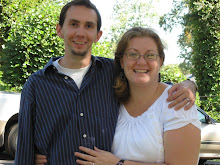Jared and I are totally enjoying our last few months here. The weather has cooled down this month about 5 degrees, but the humidity is down about 30%, so it feels so much better now! When we first got here, I about went crazy with the heat alone! I was dripping with sweat all day and night. The night here is only about 2 degrees cooler than the daytime, so when it was the hot season, it was nasty 24 hours a day. There was no escape from the heat! But like I said, now its much nicer. There is always a breeze now, too. Gravanna is the name of the season in West Africa that we are in right now. It is technically the dry season, so there is no rain, but we get the big, heavy winds from North Africa so it is really pleasant. In other parts of West Africa, Gravanna is terrible because there is no rain, its hot, and the winds are dangerous because of wild fires. But ST is a luscious rain forest, so even without rain, the jungle has precipitation and there is still food grown.
We rented a car last weekend and drove around the island a bit. There are still Rocas here that you can visit. They are the old colonial plantations. Most of them are really remote and run down, but a few of them are still operating and produce coffee or cocoa. They are really interesting to visit though, because they are little communities all their own. Most of the families that live on the rocas have been there since the plantation was built and have never been off the land! Can you imagine generations and generations living in one small area and that is it?! Each roca has a school and a hospital, if you can actually call them that. There are old run down colonial buildings that would be considered dilapidated in the US, but people are living in them here. Most everyone speaks Portuguese or some form of it, but a lot of the rocas speak a mixture of Portuguese and Forro (a local language) or a language all their own. It is so strange seeing these places. Its like walking into another world!
We also went to the Botanical Garden here which was awesome! There were samples of all kinds of tropical flowers that I have never seen before! Huge, waxy flowers that ca handle all kinds of weather and heat! There were also a lot of fruit trees, like pink and green guava, jack fruit, bread fruit, banana, papaya, and mango.
We went to a beach too, that is about 45 minutes away from the city. It is the only beach on the island that has sand dollars on it, but they are not like sand dollars you find in the US. Instead of being a circle, they look more like an octopus. The top is circular, but the bottom is cut out so that it looks like legs. They are totally weird. I think we picked up 4 or so of them. Hopefully they do not break on our way home!
